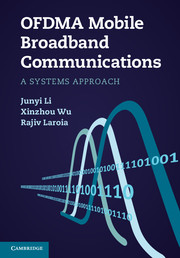Book contents
- Frontmatter
- Dedication
- Contents
- Foreword
- Preface
- List of Notation
- List of Abbreviations
- 1 Introduction
- 2 Elements of OFDMA
- 3 System design principles
- 4 Mitigation and exploitation of multipath fading
- 5 Intra-cell user multiplexing
- 6 Inter-cell interference management
- 7 Use of multiple antennas
- 8 Scheduling
- 9 Handoff in IP-based network architecture
- 10 Beyond conventional cellular frameworks
- A Overview of system operations
- B OFDM point-to-point communications
- C Brief review of channel capacity
- References
- Index
4 - Mitigation and exploitation of multipath fading
Published online by Cambridge University Press: 05 July 2013
- Frontmatter
- Dedication
- Contents
- Foreword
- Preface
- List of Notation
- List of Abbreviations
- 1 Introduction
- 2 Elements of OFDMA
- 3 System design principles
- 4 Mitigation and exploitation of multipath fading
- 5 Intra-cell user multiplexing
- 6 Inter-cell interference management
- 7 Use of multiple antennas
- 8 Scheduling
- 9 Handoff in IP-based network architecture
- 10 Beyond conventional cellular frameworks
- A Overview of system operations
- B OFDM point-to-point communications
- C Brief review of channel capacity
- References
- Index
Summary
The medium of wireless communications is the wireless radio frequency channel. We are interested in the characteristics of the wireless channel, in particular, how the channel response varies over time and frequency, as well as over the distance between a transmitter and a receiver. The variation in the channel response is usually referred to as channel fading. For a given signal, channel fading depends on the particular propagation environment, such as buildings, walls, ground, vehicles, between the transmitter and the receiver, as well as the carrier frequency of the signal. To characterize channel fading, we often use a statistical approach based on measurements made in a large variety of environments. Statistically, channel fading can be characterized by the following two different types of behaviors:
• Large-scale fading, which varies in a slow time scale (on the order of seconds) or in a large distance of many wavelengths. Large-scale fading is mainly caused by path loss and shadowing. Path loss is caused by signal strength degradation as the electromagnetic (EM) wave of the signal propagates through space. Shadowing results from penetration or reflection of objects much larger than the wavelength of the EM wave.
• Small-scale fading, which varies in a fast time scale (on the order of tens of milliseconds depending on mobility) or in a distance on the same order of the wavelength. Small-scale fading is mainly caused by multipath, as multiple copies of the transmitted signal add constructively or destructively at the receiver. Thus, small-scale fading is also referred to as multipath fading.
- Type
- Chapter
- Information
- OFDMA Mobile Broadband CommunicationsA Systems Approach, pp. 94 - 149Publisher: Cambridge University PressPrint publication year: 2013



